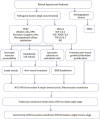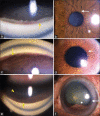Neovascular glaucoma - A review
- PMID: 33595466
- PMCID: PMC7942095
- DOI: 10.4103/ijo.IJO_1591_20
Neovascular glaucoma - A review
Abstract
Neovascular glaucoma (NVG) is a sight-threatening secondary glaucoma characterized by appearance of new vessels over the iris and proliferation of fibrovascular tissue in the anterior chamber angle. Retinal ischemia is the common driving factor and common causes are central retinal vein occlusion, proliferative diabetic retinopathy, and ocular ischemic syndrome. The current rise in the prevalence of NVG is partly related to increase in people with diabetes. A high index of suspicion and a thorough anterior segment evaluation to identify the early new vessels on the iris surface or angle are essential for early diagnosis of NVG. With newer imaging modalities such as the optical coherence tomography angiography and newer treatment options such as the anti-vascular endothelial growth factor, it is possible to detect retinal ischemia early, tailor appropriate treatment, monitor disease progression, and treatment response. The management strategies are aimed at reducing the posterior segment ischemia, reduce the neovascular drive, and control the elevated intraocular pressure. This review summarizes the causes, pathogenesis, and differential diagnoses of NVG, and the management guidelines. We also propose a treatment algorithm of neovascular glaucoma.
Keywords: Neovascular glaucoma; retinal ischemia; secondary glaucoma.
Conflict of interest statement
None
Figures









References
-
- Coats G. Further cases of thrombosis of the central vein. J. & A. Churchill. 1906
-
- Salus R. Rubeosis iridis diabetica, eine bisher unbekannte diabetische Irisveränderung. Med Klin. 1928;24:256–8.
-
- Weiss DI, Shaffer RN, Nehrenberg TR. Neovascular glaucoma complicating carotid-cavernous fistula. Arch Ophthalmol. 1963;69:304–7. - PubMed
-
- Narayanaswamy A, Baskaran M, Zheng Y, Lavanya R, Wu R, Wong WL, et al. The prevalence and types of glaucoma in an urban Indian population: The Singapore Indian Eye Study. Invest Ophthalmol Vis Sci. 2013;54:4621–7. - PubMed
Publication types
MeSH terms
LinkOut - more resources
Full Text Sources
Other Literature Sources
Medical

